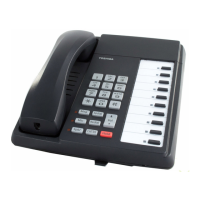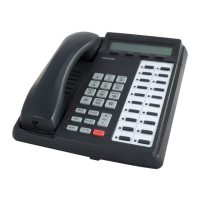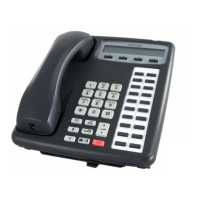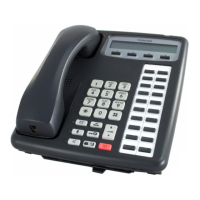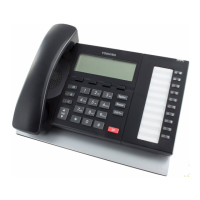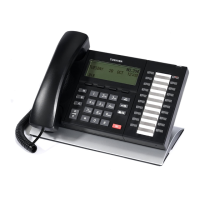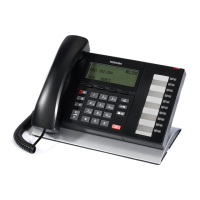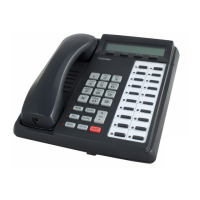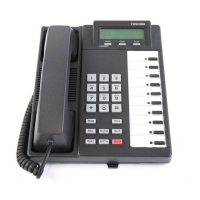
Do you have a question about the Toshiba DKT3000 Series and is the answer not in the manual?
| Programmable Buttons | Yes |
|---|---|
| Speakerphone | Yes |
| Headset Jack | Yes |
| Speed Dial | Yes |
| Ring Tones | Multiple |
| Volume Control | Yes |
| Headset Jack Size | 2.5mm |
| Type | Digital |
| Compatibility | Toshiba Strata DK, CIX, and CTX systems |
| Display Lines | 2 |
| Power Source | System Power |
Outlines the structure of the user guide, covering digital telephones, features, and consoles.
Introduces DKT3000-series models and their LCD features, including speakerphone capabilities.
Describes the function of fixed buttons on the dial pad for quick access to standard telephone operations.
Explains the role of programmable Flexible Buttons for various telephone functions.
Details the information displayed on the LCD, such as clock, calendar, and call status.
Describes the LCD control buttons and soft keys used for feature navigation and access.
Describes the fixed buttons on the DKT2000-series telephone for standard operations.
Explains the programming and variation of Flexible Buttons across DKT2000-series models.
Details the LCD display content for DKT2000-series, noting differences from DKT3000-series.
Describes the LCD control buttons and soft keys for navigating DKT2000-series features.
Advises users to consult the CTX System Administrator to identify enabled system features.
Guides users on how to identify and select different types of line access for making calls.
Prompts users to mark the specific outgoing and incoming call features available on their system.
Explains the process of initiating a call using the Hot Dialing feature without lifting the handset.
Details how to make a call by pressing the Speaker button.
Describes the procedure for making a call using the telephone handset.
Explains how to answer a call by picking up the handset.
Details how to answer a call using the speakerphone.
Describes the Handsfree Answerback feature for speakerphones.
Instructions on how to switch between handset and speakerphone modes during a call.
Provides steps to respond to a lit Message Waiting (Msg) LED indication.
Steps to transfer a call directly to a voice mailbox without ringing the extension.
Instructions for executing an immediate call transfer using soft keys.
Guides users on initiating and managing multi-party conference calls.
Explains how to transfer the master control of an ongoing conference call.
Describes how the conference master can place a conference call on hold.
Explains how to place a call on hold for retrieval only by the user who initiated it.
Describes placing a call on hold by activating another line button.
Details how to place a call on hold for a consultation before transferring.
Instructions for adjusting the handset volume during a call.
How to adjust speaker volume for various audio sources.
Adjusting volumes for ring tones and announcement features.
Steps to adjust the volume level for the handset beep tone.
Guides users on navigating and utilizing the telephone’s LCD screen for information.
Defines the various prompts displayed by soft keys and their corresponding functions.
Steps for storing an informative message to be displayed on LCD telephones.
Procedure for removing a previously set advisory message from the telephone.
Differentiates between account codes that are verified against a list and those that are not.
Explains how to use forced account codes, which must be entered before call completion.
Steps for using the Account Code button to enter voluntary codes during a call.
Procedure for entering account codes via specific access codes during a call.
Guides users on how to activate the automatic redial feature for busy numbers.
Steps for canceling the automatic busy redial feature.
Instructions for setting the automatic callback feature for busy stations or lines.
Steps to cancel the Automatic Callback (ACB) feature.
Steps to activate background music through the telephone's speaker.
Steps to deactivate background music from the telephone speaker.
How to enable background music via external paging speakers.
How to cancel background music from external paging speakers.
Explains how System Call Forward directs calls to a pre-defined destination set by an administrator.
Details how Station Call Forwarding overrides system settings for custom forwarding destinations.
Provides instructions for executing call forwarding using specific button sequences.
Steps to access and view the call history log using the Caller ID button.
Details how to pick up calls ringing stations within a designated pickup group.
Provides steps for performing various call pickup actions, including group and directed pickups.
How to answer a waiting call by placing the existing call on hold.
Steps to answer a waiting call by ending or transferring the active call.
Instructions for using DSS buttons to connect directly to another station's extension.
Steps to activate the Do Not Disturb (DND) mode on the primary extension.
How to activate DND for a non-primary extension appearance.
Procedure for deactivating the Do Not Disturb mode.
Steps to activate DND on another extension remotely.
Steps to deactivate DND on another extension remotely.
How to change the personal pass code for DND settings.
Instructions for unlocking a door using the Unlock Door button or associated code.
How to answer incoming calls from door phones and identify them.
Steps to select and change the display language of the telephone.
How to toggle the microphone cut-off feature for privacy during calls.
Steps to initiate an Off-hook Call Announce to a busy station.
How to answer an incoming Handset OCA call.
Steps to answer a Speaker OCA call.
Explains how to send a muted ring to a busy station to indicate a waiting call.
How to send a call waiting tone to a station in Do Not Disturb mode.
Steps to enter an established conversation using Executive Override.
How to override destination restrictions using an account code.
Steps to change a station’s privileges using a Class of Service Override code.
Instructions for making general page announcements to multiple stations or speakers.
Steps to make a page announcement to all stations in the All Call Page group.
How to answer an All Call Page announcement.
Steps to make an emergency page announcement.
How to make an emergency page announcement to a specific group.
How to allow other users to join a conversation on a privacy-enabled line.
Steps to enable or disable the privacy feature for calls.
Instructions for redialing the last number dialed from the telephone.
Explains the use and management of personal station speed dial numbers.
Describes the shared system speed dial numbers controlled by the administrator.
Steps to store speed dial numbers via the telephone's User Programming Mode.
Procedure for storing speed dial numbers by using specific access codes.
Explains the use of special characters and sequences in speed dial entries.
Details how long speed dial numbers exceeding 32 digits are stored and handled.
Instructions for switching the dialing mode from pulse to tone for outside lines.
Steps to transfer a call directly to a voice mailbox without it ringing.
Continues the list of soft keys for CTX Digital Telephones and their voice mail functions.
Details how to view and select named stations alphabetically from the directory.
Describes how to search internal and external directories alphabetically to save time.
Steps to assign names to station speed dial numbers for easy dialing.
Explains how users can customize their telephones by programming Flexible Buttons.
Details how to enter and exit the User Programming Mode on the telephone.
Lists the codes required to set or change the function of a flexible button.
Procedure for modifying the function assigned to a One Touch button.
Provides a list of feature access codes and their corresponding sequences for telephone functions.
Details the meaning of LED indicators on buttons and their status and interval rates.
Describes the buttons and LED indicators on the DADM3020 and DADM2020 units.
Explains DSS buttons, their station associations, and LED status indicators.
Steps to transfer an internal or outside call to an idle station.
Steps to override call forwarding using the console's associated telephone.
How to override call forwarding directly from the DSS Console.
How station extensions can match Centrex line numbering for easier dialing.
How to access Centrex features via pre-programmed flexible buttons.
Explains how distinctive ring patterns are automatically repeated for call types.
Defines the labels and functions of programmable buttons on the telephone.
